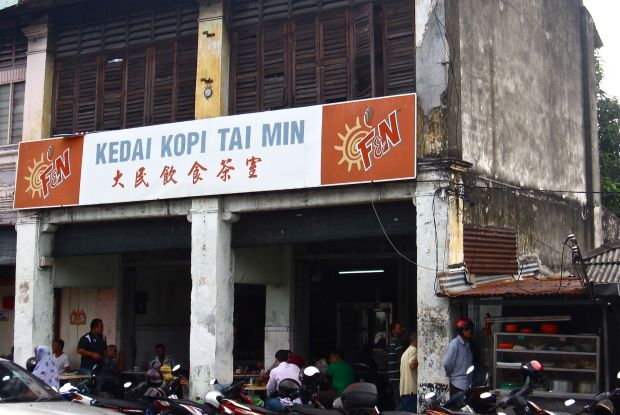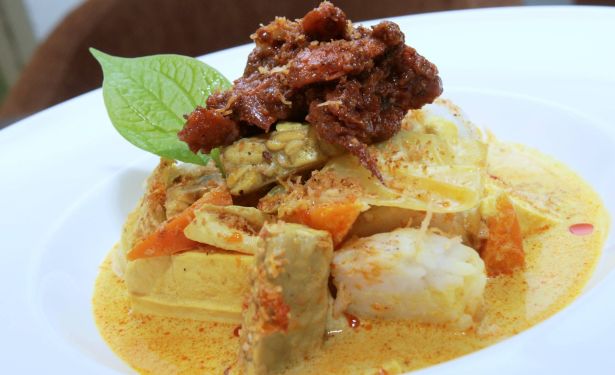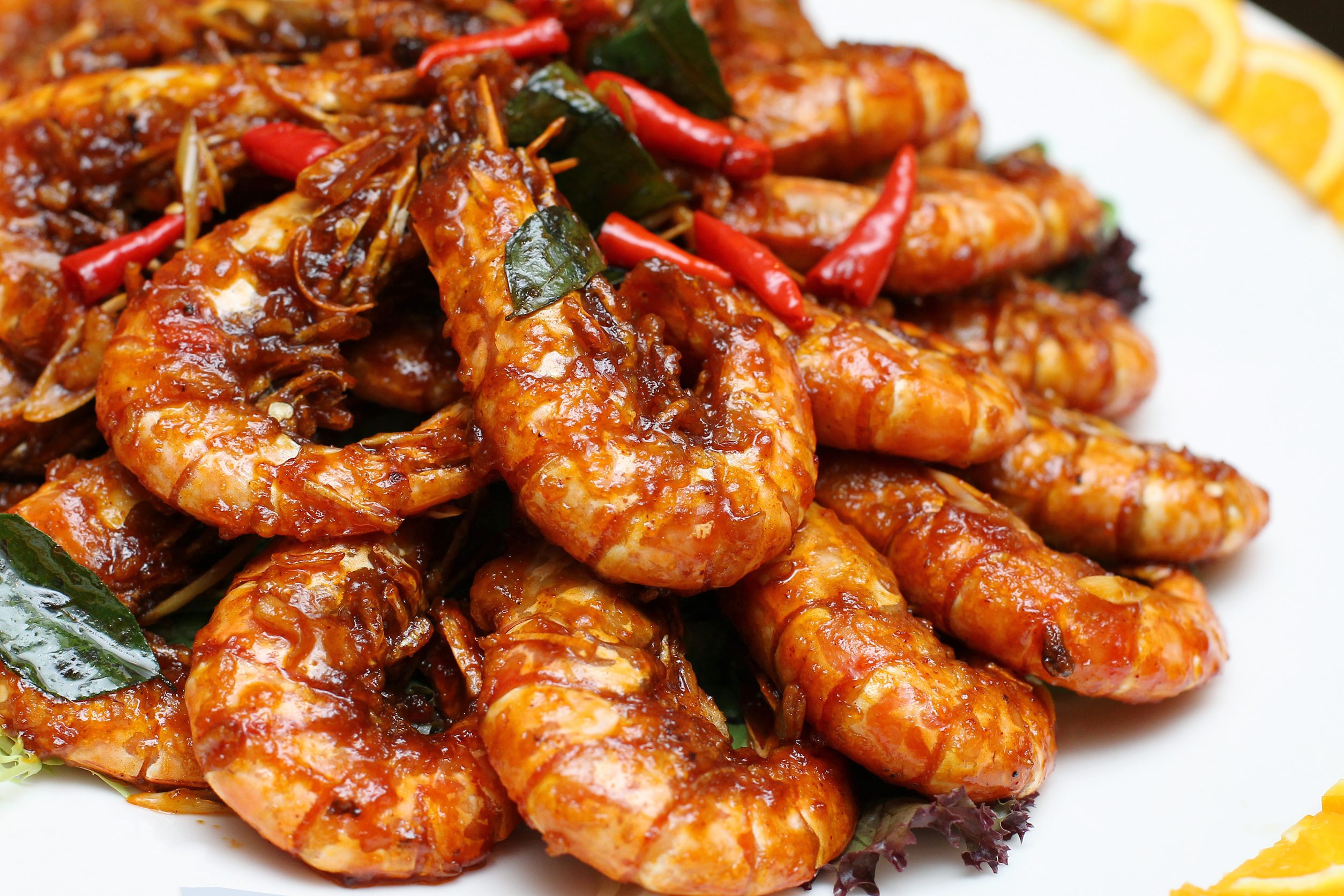 Make way: Anwar Amir (left) and a relative carrying pots of curries and dishes to the restaurant from their home across a busy street.
Make way: Anwar Amir (left) and a relative carrying pots of curries and dishes to the restaurant from their home across a busy street.
A family of nasi kandar vendors in Penang is keeping the original practice alive.
KEDAI Kopi Tai Min is the embodiment of 1Malaysia – the Chinese coffeeshop in Jalan Jelutong, Penang, is always brimming with a multi-racial breakfast crowd. It has been that way since the famous nasi kandar stall opened here some five decades ago.
Although the coffeeshop occupying two shop lots is relatively spacious, it’s always bursting at the seams. It’s not unusual to have strangers sharing a table with you when it gets very busy – which is practically every morning.
The main draw is obviously the nasi kandar, as it’s the only stall here. The family-run business was started by Anwar Amir’s grandfather who sailed to Malaya from India.
The origins of the hugely popular Penang nasi kandar date back to the 1930s when Indian Muslim immigrants roamed the port and dusty streets of colonial Penang.
Lugging around heavy baskets laden with home-cooked dishes and rice, the aroma of fragrant curries, an assortment of vegetables, fried fish, beef and chicken would hail the arrival of the nasi kandar man. Hungry customers eagerly awaited him outside their homes.
Today, the third generation has taken over what is simply known as “nasi kandar Jelutong”.
Anwar and his relatives all share cooking and serving duties.
While most nasi kandar vendors now do their cooking at the stalls come rain or shine, this family still transports the pots of dishes and rice in rattan baskets hung from a long bamboo pole from their home near the coffeeshop, just like in days of yore.
Cheap as curry
The fish curry, beef rendang, chicken and sotong masak kering are usually the first to sell out when the stall opens at the crack of dawn.
Amazingly, the rice and curries stay piping hot despite there being no stove in sight.
“The pot we cook the rice in has a narrow opening which does a good job of keeping the rice warm.
“Also, we are very fortunate that there’s always a steady stream of customers so the rice and dishes finish quite fast and we can go home to get a new batch.
“Doing this (carrying the nasi kandar in rattan baskets) keeps the family tradition alive,” he says.
 More bang for your buck:Rice, prawns,squid, fish and ladies fingers flooded with curry make for a satisfying meal.
More bang for your buck:Rice, prawns,squid, fish and ladies fingers flooded with curry make for a satisfying meal.
Customers even drive up from as far as Johor Baru just to get their nasi kandar fix.
Arriving at an ungodly hour, Kedai Kopi Tai Min is their first stop – that’s quite a compliment seeing as Penang is probably the nasi kandar capital of the country with hundreds of outlets serving the hearty fare around the clock.
Asked about the secret of the humble stall’s popularity, Anwar chalks it down to the “limited edition” dishes.
“We open for about five hours and every day we serve the same 12 dishes, so it’s (literally) ‘limited edition’,” he says.
The family runs a tight ship – there are three people manning the stall with two scooping the rice and dishes and another taking orders and packing the takeaways.
If you are standing in line or sitting near enough to the rickety wooden stall, the sound of snapping rubber bands can be heard every other minute as there are just as many bungkus customers as the dine-in crowd.
The servers are also family members who make sure that the crowd is not left waiting too long.
Despite its popularity and excellent service (each plate literally flies off the counter from the moment you place your order), prices here are among the cheapest on the island with the price of fish head starting from as low as RM3 and a juicy, decent-size prawn selling for RM3.50.
I was shocked at how a plate of “branded” (obviously because of its popularity) nasi kandar that came with chicken, squid, beef and egg was less than RM10.
Some like it wet
The best thing about the stall is how generous the servers are with the curry and gravy.
At most nasi kandar outlets, especially the popular chains, customers will have to make a special request for extra curry. Here, you actually need to inform them if you want less gravy. But according to Anwar, 80% of his customers like it “wet”.
“Whether a plate of nasi kandar is good or not depends on the taste of the curries and personally, I like my rice with lots of curry,” he says.
Anwar and his relatives have memorised their patrons preferences, however, they will ask new customers whether they want beef gravy over their rice as some Hindus and Buddhists do not eat red meat.
Anwar and his family say serving their customers well is priority.
“We will do everything for our customers; we make sure everything is cooked to perfection.
“But at home, our wives run the family kitchen – we don’t cook, we just eat,” Anwar, who learnt to cook in his teens, laughingly shares.
As in most nasi kandar outlets, all the cooks are men.
Despite the hard labour of slaving over hot stoves and transporting the heavy pots of curries and rice across busy Jalan Jelutong (several times a day, mind you) before dishing out plate after plate of orders, Anwar says the family has managed to do without foreign help.
“We do everything ourselves and we follow my grandfather’s recipes religiously till today.
“Even as the boss, I still carry the pots every day.
“If you ask me whether it’s heavy or how much it weighs, I really can’t answer because it’s already second nature to me,” he says.
In days of yore
Loyal customer Abdul Samad Karim reminisces growing up with Anwar. “I live in the kampung nearby and used to come here when I was a boy.
“Anwar’s grandfather would carry the dishes in baskets hung from a bamboo pole and visit our village. My late mother and grandmother used to tell me about how much they looked forward to his visits.
“When I was born, there was already a stall here. From what I was told, this was a ‘rest-stop’ for Anwar’s grandfather in the early days whenever he needed to catch his breath lugging all those heavy pots around the village. That’s how the stall got started here,” he said.
Abdul Samad now brings his young children to the stall regularly.
“I believe the family has been selling nasi kandar for at least 80 years (although the stall only became a permanent fixture in the 1950s) as the fourth generation of my family is still enjoying the same dishes our elders loved and often raved about,” he shares.
Asked what makes the nasi kandar his family’s favourite, Abdul Samad says simply: “Rasa asal lain daripada yang lain (an original taste that’s different from the rest).”
Citing the fish curry as his favourite, he says the taste and quality have been consistent from the time he patronised the place as a child.
Asked about the relatively cheap pricing, Anwar says the family is happy with their earnings.
“Our success is because of our regulars and we must thank them for their continuous support through the years.
“Yes, I think our dishes are the cheapest around town but it’s OK – what’s the point of charging so much when you cannot take your wealth with you when you have to leave this world?
“Our family is just happy to be earning a decent income,” he says.
Change is coming
The stall is located next to Kedai Kopi Tai Min, on Jalan Jelutong (opposite the police station). It opens from about 6am to 10.30am daily.
The stall’s days are numbered as the entire row of old wood and brick shophouses will be demolished soon.
“We have to vacate the place by December. Of course, we are a little sad but life goes on,” Anwar shrugs.
Assuring customers that the nasi kandar they love will still be around, he is, however, tight-lipped about where they will be moving next.
“It will most definitely be nearby. We are not leaving Jelutong, but we may do away with carting the dishes from home and start cooking at the new stall instead.
“There’s a possibility we may have our own shop, but let’s wait and see. I don’t want to jinx it.
“I think my grandfather would have been very proud of how far we’ve come,” he says, smiling.





